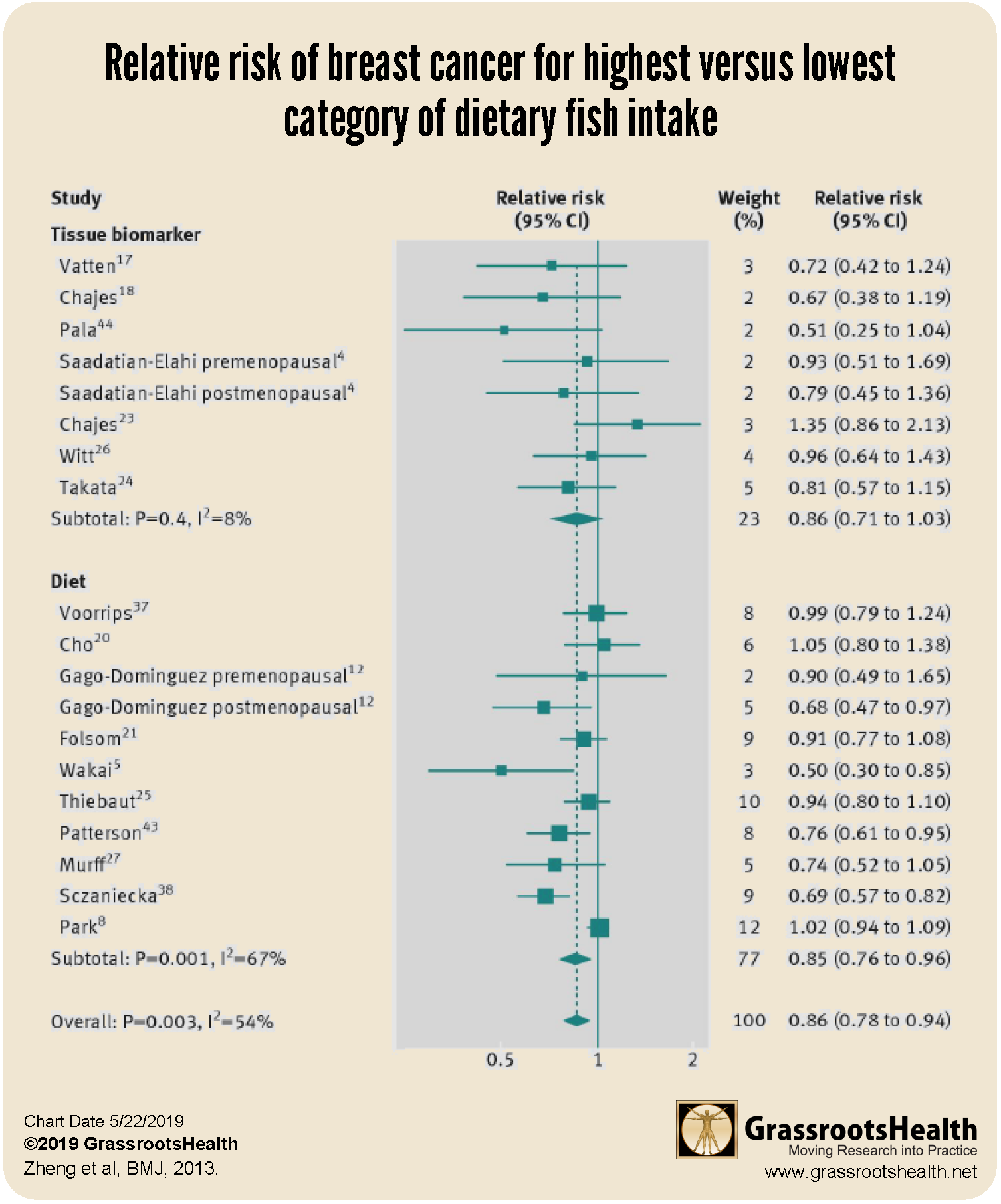Published on May 24, 2019
A meta-analysis of 21 studies on omega-3s and risk of breast cancer by Zheng et al. concludes that higher consumption of omega-3s corresponds with a lower risk of breast cancer.
The chart below is a forest plot showing the relative risk of breast cancer when comparing the highest category of omega-3, from either blood measurements or diet reports, to the lowest category of omega-3.
How do you read this chart?
The purpose of a forest plot is to help you see the forest among the trees. They are used often in a meta-analysis, such as this paper, to summarize the results from individual studies. The idea is to compare two categories for one outcome, in this case, highest vs. lowest omega 3 for risk of breast cancer. The vertical line, labeled as 1, indicates that the risk of getting breast cancer is the same for both categories. A relative risk less than 1.0 indicates lower risk with higher omega-3 and a relative risk above 1.0 indicates higher risk with higher omega-3. In this plot, most points are to the left, showing a lower risk of breast cancer with higher levels or consumption of omega-3s. Each point also has an associated bar with it – this represents the 95% confidence interval used in statistics. In reality it means the point could be anywhere along that line. Finally the big diamond at the bottom is the aggregate risk for all of the studies. In this paper they did an aggregate for just blood levels, for consumption, and for both.
Overall, those with the highest intake or blood levels of omega 3 had a 14% lower risk for breast cancer compared to those with the lowest. Please note that with vitamin D, by getting the serum level to at least 60 ng/ml (150 nmol/L), breast cancer risk was reduced by 80%. Be sure to know both levels!
What is an n-3 PUFA?
 An n-3 polyunsaturated fatty acid, also called an omega-3 fatty acid or even just omega-3, is essential for good health. Fatty acids that are not made in the body are called essential fatty acids, and must be obtained from food (or supplements). Within the omega-3 category, alpha-linolenic acid (ALA) is an essential fatty acid and while docosahexaenoic acid (DHA) and eicosapentaenoic acid (EPA) can be made from ALA, the conversion rate is very low, so they are often considered to be essential fatty acids as well.
An n-3 polyunsaturated fatty acid, also called an omega-3 fatty acid or even just omega-3, is essential for good health. Fatty acids that are not made in the body are called essential fatty acids, and must be obtained from food (or supplements). Within the omega-3 category, alpha-linolenic acid (ALA) is an essential fatty acid and while docosahexaenoic acid (DHA) and eicosapentaenoic acid (EPA) can be made from ALA, the conversion rate is very low, so they are often considered to be essential fatty acids as well.
What should you do with this information?
If you already take omega-3 supplements or eat a diet high in omega-3s, perhaps you do nothing different. This chart was derived from studies that reported on either intake or tissue biomarkers. At GrassrootsHealth we know that effectiveness of dietary omega 3 intake or supplementation varies greatly from person to person, and similarly with vitamin D. That is why we believe you need to test, not guess, and keep your Omega-3 Index at 8% or higher and your vitamin D level between 40-60 ng/ml (100-150 nmol/L) for good health. Studies in the past frequently reported only on the “groups” participants were in, how much of a supplement or drug was given to each person, not how it was received in the body. In the future we hope to see more studies that report on blood levels, as this important point about nutrient research becomes more widely understood.
Are you concerned that your omega-3 and vitamin D levels may not be at a level for potential cancer risk reduction?
Make sure you know your Omega-3 Index (with a target of 8% or higher) and your vitamin D level (with a target of 40-60 ng/ml or 100-150 nmol/L). Find out your levels today! Log on to the shop (click the link below) to get your tests and see for yourself if your levels can be improved. Use coupon code SunMonth to receive 15% off during Sunshine Month only!
Make sure you track your results before and after, about every 6 months!
Click Here to Access the Shop Page
How can I track my nutrient intake?
To help you track your omega-3 and vitamin D intake along with your resulting vitamin D level and Omega-3 Index, GrassrootsHealth has created an online tracking system called myData-myAnswers. You can track any of your supplemental and dietary nutrient intakes to see how they impact your levels and overall health. Check it out today!








